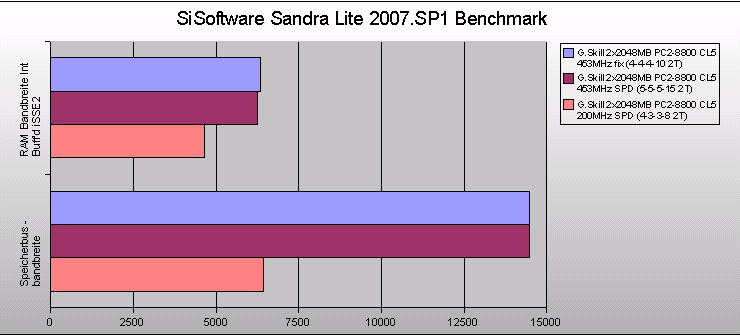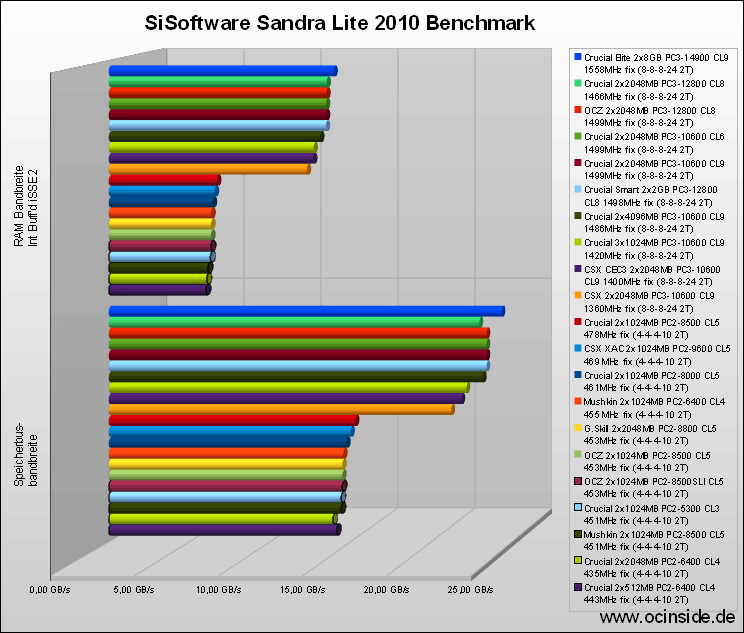
Let us continue with the most important part of the test report, the highest possible stable performance of the modules. CPU on different frequencies depending on the reference clock for the different memory benchmarks. Furthermore the memory modules were tested on another reference board to test the high frequency and higher voltages. The Foxconn C51XEM2AA motherboard comes with the nVidia nForce 590 SLI chipset and supports the EPP feature to realize an automatically adjustment of the memory timings. The multiplier adjustment remains on 9x with all frequencies, because an adjustment for the CPU in half multiplier steps would be too inaccurate to get nearly the same CPU frequency for all tests. Microsoft Windows XP Professional SP2 is used as the operating system. The stability was examined with the software Memtest86
and SiSoft Sandra Lite 2007.SP1 program is used for all benchmarks, since it offers extensive adjustments and a fast result comparison. BTW. the latest SiSoftware Sandra 2009 version is available on our server for download. All benchmarks are also included in the free Lite version.
First the maximum possible frequency of the memory module was determined. The memory frequency was increased in small steps with a fixed memory timing of 4-4-4-10 2T and default memory voltage, as long as the detailed memory test with Memtest86 runs without any errors. This quite long testing time ensured that this frequency works really stable with these modules.
The highest possible frequency at 4-4-4-10 (Tcl Trcd Tras Trp) timings was stable with very high 453 MHz !
Of course it’s possible to run much higher frequencies with increased voltages or lower timings, because the frequency values and timings depends directly from each other. Officially G.Skill specify a voltage between 1.80 and 1.90 Volt without loosing the warranty. It would be nice to have a bigger range for example up to 2.40 Volt as customary on most other high-end modules. Sure, the user can decide the maximum voltage, but the modules will loose warranty outside the manufacturer specification. But 453 MHz at CAS-4 (more than 500 MHz at CAS-5) is a nice result and thanks to the very low default voltage, the modules keep cool.
Now, this highest possible frequency was compared with two settings. On the one hand 453 MHz with SPD values (these are programmed in the SPD IC by the manufacturer), and on the other hand 200 MHz (x2) with SPD values.
By the way, the “Memory Bus Range” is no benchmark value, but this value is quite simple to calculate by the frequency and this is useful for a benchmark comparison.
Here’re the benchmark results:
| Frequency | Timing | RAM Range Int Buff’d iSSE2 | Memory bus range |
| 453 MHz | fix (4-4-4-10 2T) | 6347 MB/s | 14496 MB/s |
| 453 MHz | SPD (5-5-5-15 2T) | 6267 MB/s | 14496 MB/s |
| 200 MHz | SPD (4-3-3-8 2T) | 4664 MB/s | 6432 MB/s |
Here’s a diagram of the benchmark values:

Here is a direct benchmark result comparison of some DDR2 and DDR memory modules:

The G.Skill PC2-8800 memory kit is currently on the first place of all tested 4GB DDR2 kits, but in the summary comparison at 1.8V memory voltage it achieves in spite of the DDR2-1100 rating “only” place five. This is because the most important thing is not only the frequency specification, but also the latency specification.

